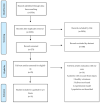The Effects of Acetazolamide on Cerebral Hemodynamics in Adult Patients with an Acute Brain Injury: A Systematic Review
- PMID: 38137126
- PMCID: PMC10741868
- DOI: 10.3390/brainsci13121678
The Effects of Acetazolamide on Cerebral Hemodynamics in Adult Patients with an Acute Brain Injury: A Systematic Review
Abstract
Background: Acetazolamide is a non-competitive inhibitor of carbonic anhydrase, an enzyme expressed in different cells of the central nervous system (CNS) and involved in the regulation of cerebral blood flow (CBF). The aim of this review was to understand the effects of acetazolamide on CBF, intracranial pressure (ICP) and brain tissue oxygenation (PbtO2) after an acute brain injury (ABI).
Methods: Following the Preferred Reporting Items for Systematic Reviews and Meta-Analyses statement (PRISMA), we performed a comprehensive, computer-based, literature research on the PubMed platform to identify studies that have reported the effects on CBF, ICP, or PbtO2 of acetazolamide administered either for therapeutic or diagnostic purposes in patients with subarachnoid hemorrhage, intracerebral hemorrhage, traumatic brain injury, and hypoxic-ischemic encephalopathy.
Results: From the initial search, 3430 records were identified and, through data selection, 11 of them were included for the qualitative analysis. No data on the effect of acetazolamide on ICP or PbtO2 were found. Cerebral vasomotor reactivity (VMR-i.e., the changing in vascular tone due to a vasoactive substance) to acetazolamide tends to change during the evolution of ABI, with the nadir occurring during the subacute stage. Moreover, VMR reduction was correlated with clinical outcome.
Conclusions: This systematic review showed that the available studies on the effects of acetazolamide on brain hemodynamics in patients with ABI are scarce. Further research is required to better understand the potential role of this drug in ABI patients.
Keywords: acetazolamide; brain injury; cerebral blood flow; cerebral oxygenation; intracranial pressure.
Conflict of interest statement
The authors declare no conflict of interest.
Figures
References
-
- Barbuskaite D., Oernbo E.K., Wardman J.H., Toft-Bertelsen T.L., Conti E., Andreassen S.N., Gerkau N.J., Rose C.R., MacAulay N. Acetazolamide modulates intracranial pressure directly by its action on the cerebrospinal fluid secretion apparatus. Fluids Barriers CNS. 2022;19:53. doi: 10.1186/s12987-022-00348-6. - DOI - PMC - PubMed
Publication types
LinkOut - more resources
Full Text Sources



